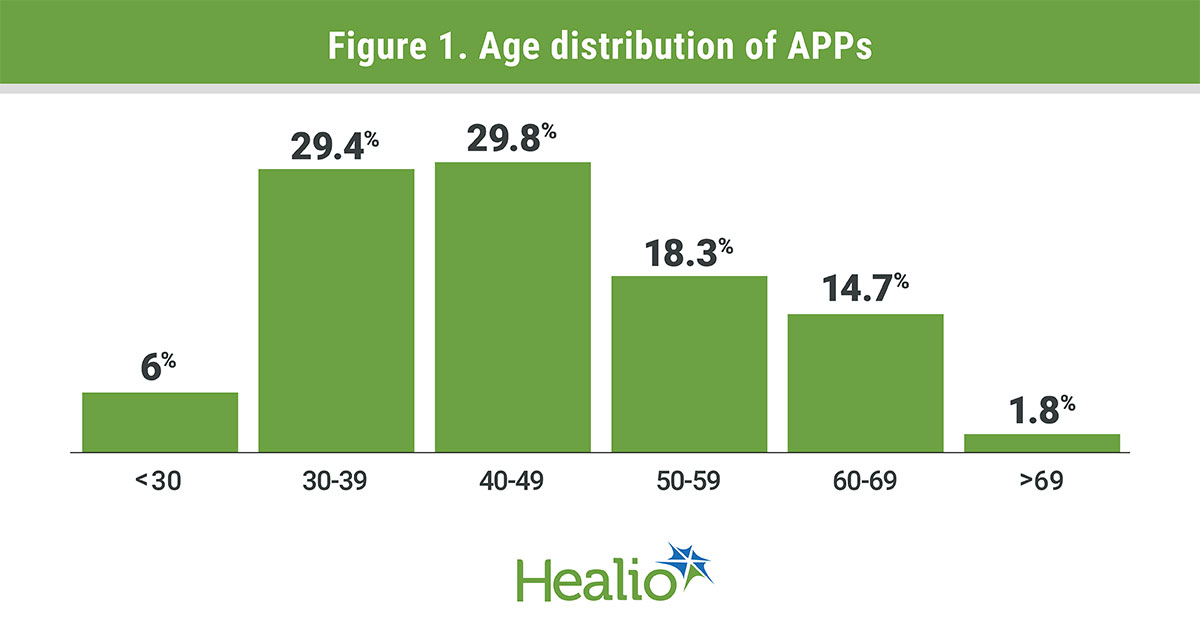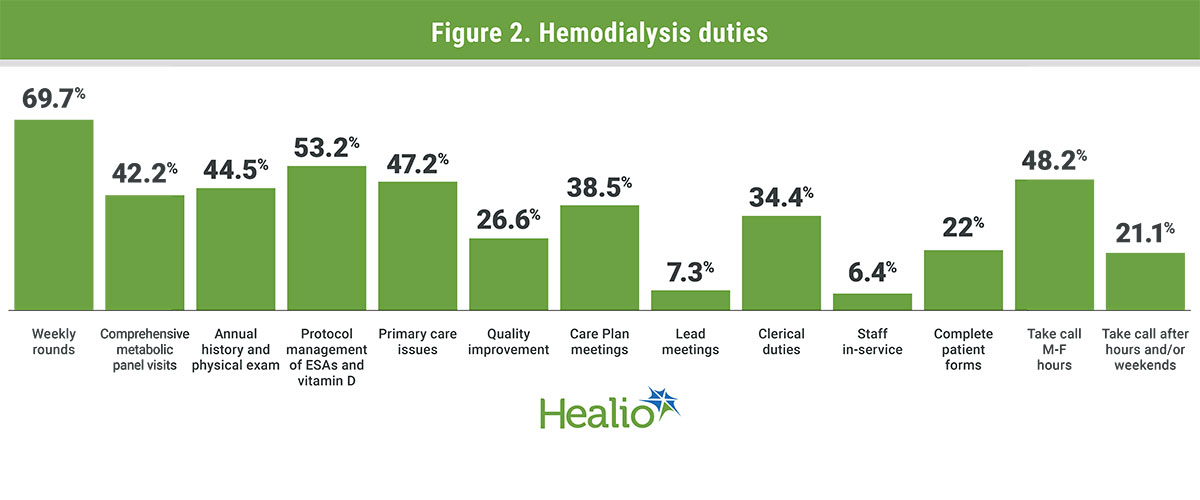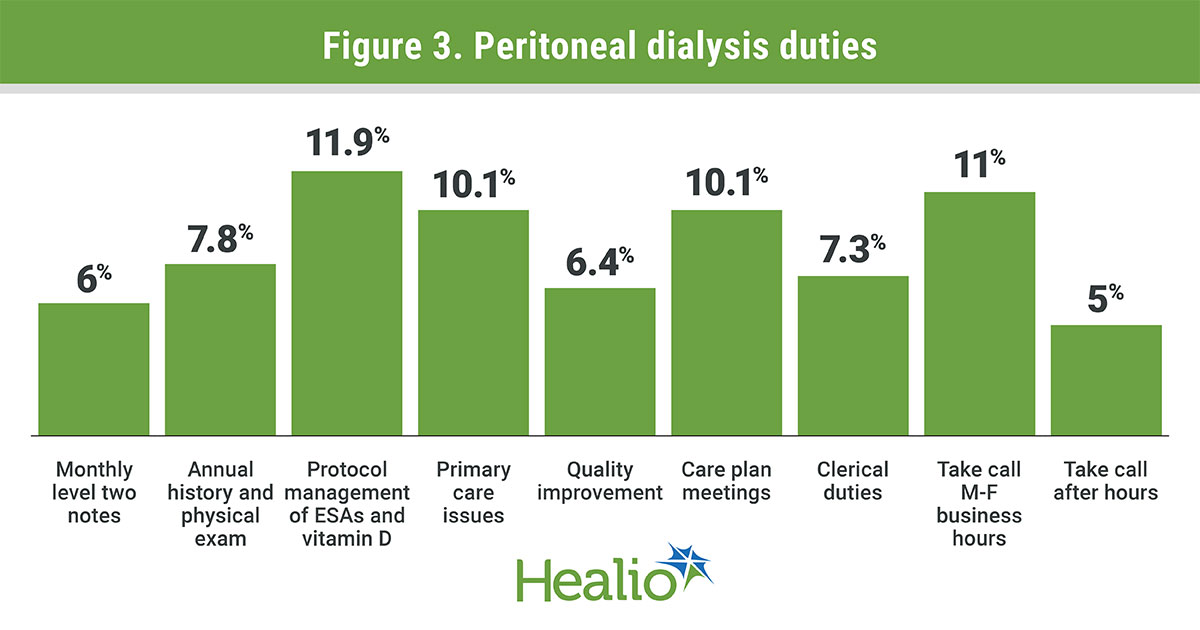Survey shows expanded role, higher salaries for advanced practice providers
The prevalence of chronic kidney disease has grown over time. Data from the CDC have shown an increase in prevalence from 12.9% from 2001 to 2004 to 13.9% from 2017 to 2020 in the United States.



It has been well documented that advanced practice providers (APPs) have taken on more duties due to the increasing prevalence of kidney disease. APPs in nephrology, which include nurse practitioners, physician assistants and clinical nurse specialists, regularly conduct visits to dialysis centers, manage patients on in-center hemodialysis and home therapies, and complete hospital rounds.
To track the APP workforce, the National Kidney Foundation conducts biennial surveys on the changing landscape in nephrology practice.
Demographics
The 2024 survey was conducted online, as in previous years, and this year garnered responses from 218 kidney professionals, constituting approximately 25% of the NKF Council of Advanced Practice Providers membership. This participation rate is comparatively lower than in the 2020 and 2022 surveys.
Participation was reported from 47 states, excluding Delaware, Rhode Island and South Dakota. Among survey respondents, 70% were nurse practitioners (NPs) and 30% physician assistants (PAs) with 76% holding master’s degrees. Participants were aged 30 to 69 years and older, and many did not have prior nephrology experience before working as a nephrology APP. Among APPs responding to the survey, 89% were women.

Source: NKF CAPP Salary & Benefits Survey.
Among respondents, most said they were white (n = 181; 83%). Respondents indicating they were Asian (n = 16) and Black or African Americans (n = 10) made up around 7.3% and 4.6%, respectively, of the total; 4.6% of the sample identified as Hispanic or Latino (n = 10).
A notable shift in the age demographics of APPs is evident when comparing respondents from the 2022 survey to the 2024 survey. In 2024, a younger generation of APPs is more predominant among the survey respondents (see Fig. 1), with 29.4% (n = 64) in their 30s, 29.8% (n = 65) in their 40s and 18.3% in their 50s (n = 40). The age categories with the fewest respondents were 60 to 69 years (n = 32; 14.7%) and younger than 30 years (n = 13; 6%). This shift could be attributed to the retirement of older APPs, possibly accelerated by the COVID-19 pandemic.
The 2024 survey respondents were relatively newer to the specialty of nephrology, with 75 (34.4%) having less than 5 years of experience and another 65 participants (29.8%) having between 5 and 10 years of experience. This essentially means around 64% of nephrology APPs responding to the survey had less than 10 years of experience.
The frequency begins to curtail with increasing years of experience, with 39 participants (17.9%) having between 11 and 15 years of experience, 22 participants (10.1%) having between 16 and 20 years of experience, 12 participants (5.5%) reporting experience between 21 and 25 years, and only five participants (2.3%) indicating they had more than 25 years of experience.

Source: NKF CAPP Salary & Benefits Survey.
This year, the survey included a new question regarding training when transitioning to nephrology. Thirty-one percent of APPs said they had no formal training in nephrology. Most APPs surveyed (83.9%) reported informal mentorship or on-the-job training. Surprisingly, 145 (66.5%) of APPs had no clinical experience in nephrology before working in that specialty.
Salaries, benefits and PTO
The 2024 survey revealed a 1.57% difference in the highest yearly salary for PAs ($129,000) compared with NPs ($127,000), highlighting a slightly wider gap – and higher salary for PAs – compared with last year’s survey showing a high NP salary of $119,580 vs. $118,200 for PAs. The salary of APPs has been on a steady upward trajectory since 2010, according to the surveys, crossing the six-figure mark in 2016. From 2022 to 2024, NP and PA overall salaries increased by 7.6%.
Most participants in the survey (n = 147; 67.4%) indicated they had received a raise in 2023 and a small fraction (n = 29; 13.3%) received a raise in 2022. The most frequent raise was 1% to 3% (n = 117; 53.7%). Respondents said raises were given for performance (n = 92; 42.2%), to provide a competitive salary (n = 75; 34.4%), longevity (n = 43; 19.7%) and productivity (n = 42; 19.3%), with a small number of respondents reporting getting a raise incentive based on relative value units payments (n = 10; 4.6%). In the survey, 91 participants (41.3%) reported receiving a bonus in 2023.
Many participants (88.1%) received paid time off to obtain CME credits. Participants reported being paid for holiday coverage (n = 42; 19.3%), weekend coverage/on-call (n = 16; 7.3%), taking calls after hours (n = 14; 6.4%) and general overtime work (n = 9; 4.1%). Many participants reported practices covered the cost of subscriptions to medical periodicals, licensing and certification fees and dues to organizations.
Nephrology APP duties
The most reported practice site for nephrology APPs was the hemodialysis (HD) unit (n = 164; 75.2%), followed by outpatient office (n = 126; 57.8%), hospital rounds (n = 84; 38.5%) and peritoneal dialysis rounds (n = 45; 20.6%). Other less frequent areas of practice were pediatric nephrology (n = 27; 12.4%) and interventional nephrology (n = 3, 1.4%).
Of those that reported conducting in-center HD visits, 51 survey participants (23.4%) reported one to 49 visits per week, 44 participants (20.2%) reported conducting 50-99 visits and 39 participants (17.9%) conducted 100 or more HD visits.
Other duties included participation in education-related activities (54.1%; n = 118); administrative duties (27.1%; n = 59) and reported research duties (20.2%; n = 44).
Hemodialysis duties
The top three hemodialysis duties included weekly rounds (n = 152; 69.7%), protocol medication management (n = 116; 53.2%) and Monday to Friday calls (n = 105; 48.2%). Other hemodialysis duties included conducting capitated monthly visits (n = 92; 42.2%), history and physicals (n = 97; 44.5%), primary care concerns (n = 103; 47.2%), quality improvement (n = 58; 26.6%), care plan meetings (n = 84; 38.5%), clerical duties (n = 75; 34.4%), insurance and disability forms (n = 48; 22%) and after-hours calls (n = 46; 21.1%). Figure 2 summarizes the main duties of the APPs in the hemodialysis patient population.
Peritoneal dialysis duties
As previously mentioned, nephrology APPs performed peritoneal dialysis duties at a lower frequency relative to hemodialysis duties. In the survey, 43 respondents (19.7%) report seeing patients on PD in the hospital setting and another 33 respondents (15.1%) report seeing patients in the PD outpatient office (see Figure 3). Specific duties for patients on PD included level-two monthly follow-up visits (n =13; 6%), history and physicals (n = 17; 7.8%), protocol management of vitamin D and anemia management (n = 26; 11.9%), primary care concerns (n = 22; 10.1%), quality improvement (n = 14; 6.4%), care plan meetings (n = 22; 10.1%), clerical duties (n = 16; 7.3%), taking calls during business hours (n = 24; 11%) and taking calls after hours (n = 11; 5%).
Hospital duties
Hospital coverage was reported as a significant responsibility for nephrology APPs (n = 84; 38.5%). A small frequency (n = 31; 14.2%) held medical staff membership. Main hospital duties included patient rounds (n = 85; 39%) and consults (n = 84; 38.5%). Other common duties reported were history and physical examinations (n = 36; 16.5%), taking calls during business hours (n = 37; 17%) and ICU management (n = 26; 11.9%). Some uncommon duties reported included after-hours calls (n = 22; 10.1%), participation in hospital committees (n = 19; 8.7%), kidney education (n = 15; 6.9%) and quality improvement (n = 11; 5%).
Research duties
Many respondents were not involved in research (n = 174; 79.8%). The major duties reported in the survey were monitoring patients in ongoing trials (n = 27; 12.4%), collecting data for ongoing trials (n = 25; 11.5%) and attending investigator meetings (n = 12; 5.5%). Other duties reported included writing and publishing research (n = 8; 3.7%), initiating individual research (n = 7; 3.2%) and presenting research at national meetings (n = 6; 2.8%). Of the APPs who did report research duties, only two participants (0.9%) reported writing grant applications. Individuals reported holding the title of subinvestigator the most frequently (n = 26; 11.9%), with several holding the titles of primary investigator (n = 5; 2.3%) and study coordinator (n = 6; 2.8%).
Education, administrative duties
Educational duties were more frequently reported (n = 118; 54.1%) than research responsibilities. Common duties reported included mentoring advance placement students during clinical rotations (n = 74; 33.9%), orienting and training new APPs (n = 70; 32.1%), teaching kidney disease education classes (n = 34; 15.6%), and lecturing clinic and/or office staff (n = 32; 14.7%).

Source: NKF CAPP Salary & Benefits Survey
Slightly more than 25% of participants reported administrative and/or supervisory responsibilities (n = 59; 27.1%). Responsibilities reported were supervision of other APPs (n = 27; 12.4%), making work schedules (n = 22; 10.1%), supervision of clinic staff (n = 16; 7.3%) and maintaining meeting minutes (n = 16; 7.3%). A small proportion of participants (n = 6; 2.8%) reported supervising non-clinic staff.
In summary, salary continues to trend up with each succeeding survey for nephrology APPs. The landscape continues to evolve, with APPs continuing to take on greater responsibilities in the clinical and the nonpatient-facing aspects of nephrology.
It is difficult to predict how the role of APPs in nephrology will change; however, it is reasonable to assume continued growth in the presence of APPs. As the prevalence of CKD continues to increase, so will the need for nephrologists and nephrology APPs.
- References:
- CDC. Chronic Kidney Disease Surveillance System - United States. Available at: https://nccd.cdc.gov/ckd/detail.aspx?Qnum=Q372. Accessed June 17, 2024.
- https://www.healio.com/news/nephrology/20210204/advanced-practitioners-in-nephrology-show-diverse-integration. Accessed June 17, 2024.
- https://www.healio.com/news/nephrology/20220531/survey-advanced-practitioners-manage-more-hospital-coverage-home-dialysis-and-telehealth. Accessed June 17, 2024.
- Acknowledgements
- The authors want to thank the National Kidney Foundation’s Council of Advanced Practitioners, Kim Zuber PA-C, Ian Rios, DNP, CNN-NP and Kirsten Jensen, DNP, CNN-NP for access to and analysis of the survey data.
- For more information:
- Analiza P. Guerrero, DNP, ANP-C, CRNP, CNN-NP, is with Metropolitan Nephrology Associates, P.C. in Philadelphia and can be reached at analiza.guerrero20@gmail.com.
- Toddra S. Liddell, MSN, FNP-C, PMHNP-BC, is an associate in medicine with the division of nephrology and hypertension at Vanderbilt University Medical Center in Nashville. She can be reached at toddra.s.liddell@vumc.org.
- Daniel Mead, DNP, MSCE, AGNP-C, CNN-NP, CHSE, FNKF, is an assistant professor of nursing (epidemiology and biostatistics) at Rosalind Franklin University of Medicine and Science College of Nursing and chief nurse practitioner (general nephrology) at Shifa Nephrology Associates. He can be reached at nurse3710@gmail.com.
